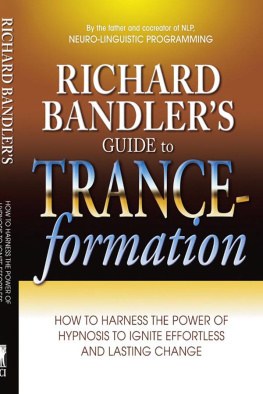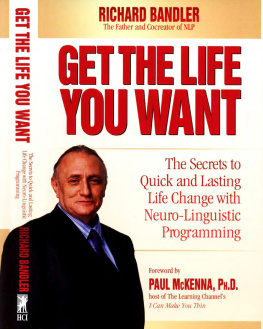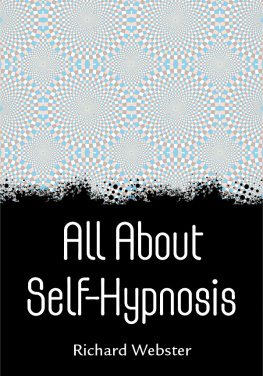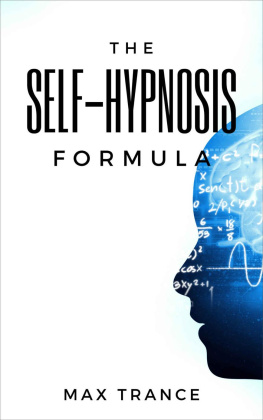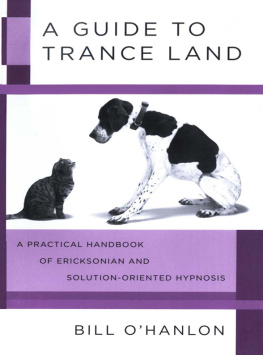Tranceformations. NeuroLinguistic Programming and
the Structure of Hypnosis
Hypnosis is a word that usually gets strong responses from peoplesome positive and some negative. Some people think it's a hoax or only good for making people act like chickens, some people think it will cure everything from dandruff to flat feet, and others think it is so dangerous that it should be left alone completely. Trance experiences have existed in different forms for centuries, usually surrounded by a mystique of something "magical" and unexplainable. What is unique about this book is that it turns the "magic" of hypnosis into specific understandable procedures that can be used not only in doing "hypnosis" but also in everyday communication.
When John Grinder and Richard Bandler do a seminar on hypnosis together, one of them usually says "All communication is hypnosis" and the other says "I disagree, nothing is hypnosis; hypnosis doesn't exist." There is a sense in which they are both right, and both are saying the same thing.
If I tell you about going snorkeling on my recent honeymoon in the Yucatan and describe to you the swift movements of the brightlycolored tropical fish, the rhythmic sound of the gentle waves against the shore, and the feeling of rising and falling with the warm waves as I scan the underwater scenery, hopefully I will alter your state of consciousness so that you can experience some representation of what I experienced. If you become excited about going there yourself, I will have used the same patterns of communication that are used by successful hypnotists and by successful poets, salesmen, parents, politicians, religious leaders, etc. If you think of hypnosis as altering someone's state of consciousness, then any effective communication is hypnosis.
One of the simpler hypnotic patterns is the "negative command." If I say "Don't think of blue," you have to think of blue in order to understand my sentence. If a hypnotist says "I don't want you to relax too soon" the listener often finds himself beginning to relax as a way of understanding what those words mean. Beginning with a negation simply takes any pressure to respond off the listener.
The same pattern is often inadvertently used to get unwanted responses. The wellmeaning parent may say to her child "Don't spill the milk," or "Don't stumble." The wellmeaning husband may say "Don't get upset," or "I don't want you to worry about what happens while you are gone." The listener has to represent the unwanted behavior somehow in order to understand what has been said, and this makes the unwanted behavior more likely. Unknowingly, he or she in a sense "hypnotizes" the child or spouse into an unwanted response.
The same pattern can be used to get more useful responses from people, whether they are in "trance" or not. "Don't be too curious about what you'll learn from reading this book." "I wouldn't tell you to be eager to discover how you'll change comfortably in the coming weeks." Since hypnosis is fundamentally no different than any effective communication, "There is no such thing as hypnosis" as a separate and distinct process.
Most books present hypnosis as something that you sit down and do with yourself or someone else for a discrete period of time, usually to solve problems. Then you get up and do something else. If you still think of hypnosis in that way after you have read this book, you will be depriving yourself of the most important ways you can use these toolsin your living. The communication patterns described in this book are far too useful to leave on a hypnosis chair somewhere. Most of the satisfactions that we all want in life don't take place in a hypnosis chair; they happen with the people we love, the work that we do, and the ways that we play and enjoy life.
You can use the information in this book in many ways, both personally and professionally. One way is to make remedial changes by solving problems and removing limitations. This is the way hypnosis is usually used to stop smoking, lose weight, deal with unreasonable fears, and so on.
But you can also use this information in evolutionary ways to develop yourself and continually increase your abilities and choices in life learning to do better what you already do well. You can do this in simple ways such as learning to communicate with family and associates more effectively, make love more enjoyably, learn new skills more easily, and so on. You can also learn how to make even more pervasive changes in how you live.
Much of the material in this book is derived from Bandler and Grinder's careful and systematic observation of the work of Milton H. Erickson, M.D. Until his death in 1980, Erickson was widely considered to be the world's greatest medical hypnotist. He was widely known for his successful and often "miraculous" work with "impossible" clients, as well as for his extensive writings on hypnosis.
Several years ago I went to visit Milton Erickson at his home in Phoenix. After he described some of his remarkable work with clients, I asked him how he knew to use one approach with one client, when he had used an opposite approach with another client who apparently had the same kind of problem. He responded "You just trust your unconscious mind,"
That approach to hypnosis works great if you have Milton Erickson's unconscious mind. But how is it possible to learn to automatically and unconsciously respond as effectively as Milton Erickson didto have an unconscious mind like Erickson's? Grinder and Bandler's special genius is the ability to observe someone like Erickson and then describe in detail what Erickson does, what cues he responds to, and how it all fits together. This makes it possible for others to learn how to repeat the same procedures and get similar results. After a period of practice, these patterns can become as automatic as knowing which muscles to move in order to reach across a table and pick up a glass.
Erickson wrote the following in the preface to Bandler and Grinder's book The Patterns of the Hypnotic Techniques of Milton H. Erickson, M.D.:
"Although this book by Richard Bandler and John Grinder, to which I am contributing this Preface, is far from being a complete description of my methodologies, as they so clearly state it is a much better explanation of how I work than I, myself, can give. I know what I do, but to explain how I do it is much too difficult for me."
In addition to modelling the behaviour of "wizards" such as Milton Erickson, Grinder and Bandler have added their own wide array of effective communication skills to the body of knowledge that they teach others. It is unusual to find two people like Bandler and Grinder who are such powerful and effective communicators. It is even more unusual to find two people who are so capable of teaching others to do what they do so exquisitely.
The material presented in this book is detailed and specific and carefully sequenced, beginning with simple concepts and exercises, and proceeding stepbystep to more advanced procedures. This book has been created from verbatim transcripts of10 different seminars on hypnosis, edited together so that it appears as a single workshop. No distinction is made between when Richard is speaking and when John is speaking, and the names of most participants have been changed.
As you read this book, keep in mind that Bandler and Grinder are usually doing what they're talking about. Sometimes they're explicit about this, and sometimes they're not. The astute reader will find much more in the text than is overtly commented upon.
This book has been edited so as to keep redundancy with other NLP books to a minimum. Some material from the original workshops which is already available in other books has been omitted. You will find that the books



